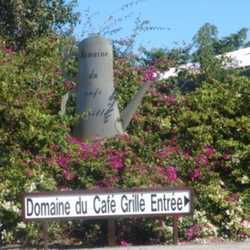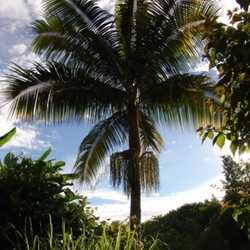Also called ‘mirliton' and ‘alligator pear' in Louisiana this plant is Sechium edule (syn. Sicyos edulis) and belongs to the rather large Cucubirtaceae family which comprises over 900 species divided between 120 different genera. The Sechium genera is monospecific, which means it only consists of one single species (ergo S.edule). Chouchou is the name we use here on Reunion Island, chayote and christophine is the one in French West Indies (Martinique and Guadeloupe), in Mexico it will be chucho, sôsety will only help you in Madagascar and choko will work down under (Australia and New-Zealand). Plants of this family are mostly climbers which cling to any available support by the mean of tendrils, annuals or perennials, grown on a large scale for various purposes. From cucumber to cantaloupe, water-melon to pumpkin, squashes and a whole paraphernalia of decorative gourds they are well known all over the world. But although you can get gherkins in any super-market or luffa (so-called ‘vegetable sponge') in most health store, chouchou will not appear that commonly at your favorite shop unless it is run by folks from Latin America or South Eastern Asia...The geographical origin is Mesoamerica which today translates as Mexico and Guatemala. Unsurprisingly it is in Guatemala that the largest diversity of cultivars and varieties will be found. The plant was grown by the Aztecs and many less known native groups of the area. It was introduced in the West Indies and Brazil during the 18th century and actually travelled all the way from Rio de Janeiro to reach Reunion Island in 1834. From there it was brought to Algeria (at this time a French colony just like Reunion) in 1845 from where it has spread around Mediterranean. The Spanish conquista brought it all over South America and it is nowadays grown all over the tropics and a genuine ingredient in South American as well as Thai or Chinese cuisine!
 The plant is a perennial herbaceous climber with fluted stems up to one centimeter thick and which can grow up to eight or ten meters long hence able to cover rather serious trees. The leaves are large, up to 20 cm long and in width, slightly rough with hairy nerves underneath. The tendrils end in two to five smaller twigs. Male and female flowers are separated (monoecious) the male ones come in clusters while female ones are solitary. The fruit or chouchou is a pear-shaped berry reaching a weight of 500g to
The plant is a perennial herbaceous climber with fluted stems up to one centimeter thick and which can grow up to eight or ten meters long hence able to cover rather serious trees. The leaves are large, up to 20 cm long and in width, slightly rough with hairy nerves underneath. The tendrils end in two to five smaller twigs. Male and female flowers are separated (monoecious) the male ones come in clusters while female ones are solitary. The fruit or chouchou is a pear-shaped berry reaching a weight of 500g to 1kg, bearing furrow lengthwise. Depending on the variety they can be with or without spines, the skin varying from white to dark green with all the shades in-between.
1kg, bearing furrow lengthwise. Depending on the variety they can be with or without spines, the skin varying from white to dark green with all the shades in-between.
As an edible species it really goes to great length to feed the hungry ones; not only the fruits (the chouchou themselves) can be eaten but the seeds can be found on street markets as a delicacy, the young shoots and leaves are widely sold to be cooked as ‘brédes' (see this article on the subject) and even the tuberous roots can be used as food (known on Reunion as 'chinchayote' or ‘patate chouchou as anything growing in the ground is a ‘patate', sorry no idea of its name in other places...), leaving maybe only old tendrils for you chickens and rabbits. And this stunning chouchou can be eaten off hand when it still young but you really have to be hungry, the taste is dull and it may leave your mouth sticky as the sap is rather skin-friendly...So if you can spare some time the advice is to slice the thing and have it sit in lemon juice for a while, then it will make an acceptable salad. Now you will probably like it better cooked and there are many recipes, from the basic boiled thing served with butter to light sauté with onions and garlic or more elaborate ‘gratin de chouchou' with grated cheese on top and set in the oven. As a matter of fact this one vegetable can be used as potatoes or squash which means that only your culinary imagination will be the limit, who is ready to try chouchou French fries o chouchou purée? The ‘patate chouchou' or tuber is not seen often on sale as it implies the death of the plant, the taste and consistency is close to the potato, it is also more nutritious as it contains 10 to 15% starch and 2.5% of nitrogenous substances. The chouchou itself is a choice diet food as it only contains 3 to 4% glucides, 1% proteins and 0.20 to 0.80% lipids with 90 to 92% water, hence a perfect balance if you over-indulge into hamburgers...Besides human consumption the plant is also frequently used as fodder so with the same material you can get both meat and vegetables, just grow some corn and you have a complete menu at hand. Apart from the kitchen and stables, chouchou can also be found in the house pharmacy; it relieves efficiently burns if grated and applied on the skin, it will also be effective against spots on the skin and is recommended when breast-feeding as it has lactogenic properties (helps producing milk). It is also used to treat whooping cough. Old stems can be stripped of their fibers which on Reunion are traditionally used to plait hats.
Growing this plant is quite easy, it will thrive in any wet and fresh areas (it does best at 18 to 22°C, 64 to 71°F) between 500 and 1200m in elevation (1500 to 3600 feet). As the fruit starts germinating if left aging on the plant you simply have to remove older fruits and sow them directly by putting them halfway in the ground, preferably in deep loose rich soil so as to allow the tuberous roots to freely develop. Distance between two plants should be anywhere between 4 and 10m (12 to 30 feet) as they need space. If it is grown solely for stems and tubers it can be simply left crawling on the ground but for fruit producing a arbour will be needed, making harvest much more easy and avoiding slugs and snails to start eating before you. Wire meshes can be used; tree branches or bamboos are also often seen as props on Reunion. After four months the first stems can be harvested and the first fruits will take six to eight months to be ready. During the first year one hectare (10.000 square meters) will yield 30 to 50 tons and may reach 100 tons on the second year. On Reunion it is grown in many gardens and has largely escaped in the wild, it is grown on a large scale in Salazie which is on the East coast and gets regular rainfalls which the plant love, it has become such an important thing there that they even have a ‘Miss Chouchou' election every year! And one of the restaurants in Salazie is adequately names ‘Au p'tit chouchou'.
What else to say? Run to you closer exotic food store and get yourself a bagful of chouchou, then bon appétit chers lecteurs!

















